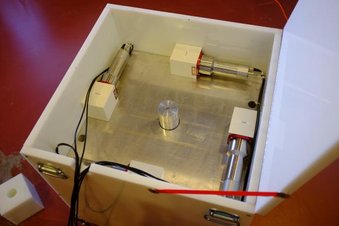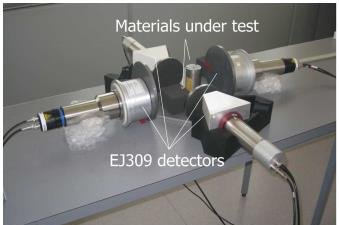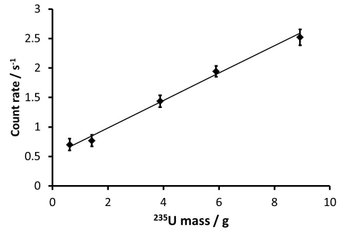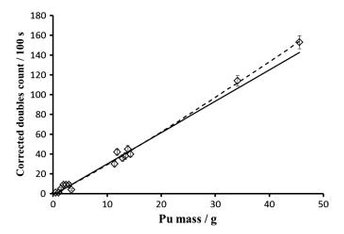Hybrid Instruments Ltd.
Real-Time Analysis
Plutonium/uranium assay
The standard approach to the non-destructive assay of fissile nuclear materials such as plutonium and uranium (generally 239Pu and 235U, respectively) is to detect the neutron emission either via the stimulus with an external source of neutrons or via the detection of those emitted by spontaneous fission. To isolate the emission associated with the fissile component (that arising from stimulated fission in either 239Pu or 235U or spontaneous fission in 240Pu) as opposed to other sources of neutrons such as (alpha,n) reactions or scatter in the environment, the correlation of the neutrons with time is taken. This requires that at least pairs of neutrons detected together are recorded in preference to single, uncorrelated neutrons.
The most popular means of neutron detection is to thermalise the neutrons in polyethylene and then detect with detectors based on 3He; the thermalisation process requires time however and this limits the accuracy of the detection method because uncorrelated neutrons have a greater chance of detection than if the neutrons could be detected without thermalisation. This, in turn, leads to long acquisition times or, conversely, lower levels of accuracy than are possible with a fast neutron approach.
The real-time pulse-shape discrimination of Hybrid Instruments analysers enables the measurement of both plutonium and uranium mass without the need for thermalisation, more rapidly and to competitive levels of accuracy.
This approach removes the concern over ‘accidental’ events i.e. neutrons that are not associated with the fissile material and contaminate the response of the system. It also removes the need for heavy and bulky quantities of moderator.
The fissile material assay of uranium (upper) and of plutonium (lower),
(Joyce et al., IEEE Trans. Nuc. Sci. (2014)).
Associated publications
A. Lavietes, M. Pickrell, R. Plentada, M. Mascarenhas, C. Liguori, M. D. Aspinall and M. J. Joyce. (2011)
Liquid scintillator neutron detection for real-time nuclear material assay. IEEE Nuclear Science Symposium.
A. D. Lavietes, R. Plenteda, N. Mascarenhas, L. M. Cronholm, M. D. Aspinall, M. J. Joyce, A. Tomanin and P. Peerani. (2012)
Liquid scintillator-based neutron detector development. IEEE, Nuclear Science Symposium and Medical Imaging Conference (NSS/MIC), Pages 230-244.
A. Lavietes, R. Plentada, N. Mascarenhas, L. M. Cronholm, M. D. Aspinall, M. Joyce, A. Tomanin and P. Peerani. (2013)
Development of a liquid scintillator–based active interrogation system for LEU fuel assemblies. IEEE, 3rd International Conference on Advancements in Nuclear Instrumentation Measurement Methods and their Applications (ANIMMA), Marseille, France, Pages 1-4.
M. M. Pickrell et al. (2013)
The IAEA Workshop on Requirements and Potential Technologies for Replacement of 3He Detectors in IAEA Safeguards Applications. Journal of the Institute of Nuclear Materials Management 03/2013; 41(2):14-29.
A. Lavietes, M. J. Joyce, R. Plentada, M. Mascarenhas, M. Cronholm, M. D. Aspinall, F. D. Cave, A. Tomanin and P. Peerani. (2013)
Real-time measurements of production uranium fuel assemblies using a liquid scintillator-based active interrogation neutron detection system. IEEE Nuclear Science Symposium, Seoul, South Korea, Pages N39-2.
M. J. Joyce, K. A. A. Gamage, M. D. Aspinall, F. D. Cave and A. D. Lavietes. (2014)
Real-time, fast neutron coincidence assay of plutonium with a 4-channel multiplexed analyzer and organic scintillators. IEEE Transactions on Nuclear Science, Volume 61, Issue 3, Pages 1340-1348.
H. M. Parker, M. D. Aspinall, A. Couture, F.D. Cave, C. Orr, B. Swinson and M. J. Joyce. (2016)
Active fast neutron singles assay of 235U enrichment in small samples of triuranium octoxide. Progress in Nuclear Energy, 93, p59-66.




